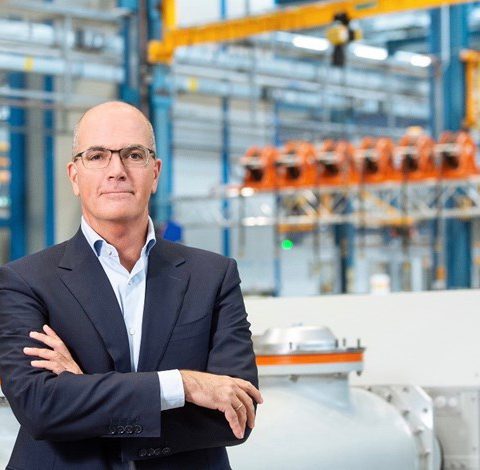Hitachi Energy sees the light today. The rebranding is concluded
Hitachi Energy is, from today, the new brand name of the formerly known Hitachi ABB Power Grids. The business has renewed its Purpose to «advancing a sustainable energy future for all». New brand was announced in summer 2021. Through its Sustainability 2030 strategic plan, Hitachi Energy is addressing the urgency of the global energy transition and has set […]

Hitachi Energy is, from today, the new brand name of the formerly known Hitachi ABB Power Grids. The business has renewed its Purpose to «advancing a sustainable energy future for all». New brand was announced in summer 2021.
Through its Sustainability 2030 strategic plan, Hitachi Energy is addressing the urgency of the global energy transition and has set clear targets in: Planet, People, Peace and Partnerships. Hitachi Energy has set targets to become carbon-neutral in its own operations and it expects to hit the first-step target achieving 100% fossil-free electricity in its own operations by 2022.
Hitachi Ltd. has an 80.1 percent stake in the joint venture which started operations on July 1, 2020, and ABB Ltd. holds the balance.
Regarding the bus-related sector, Hitachi ABB Power Grids acts as a supplier of charging infrastructures for e-buses, with a recent agreement being reached with the UK-based startup Arrival. The company is sponsor of the Sustainable Bus Tour 2021 and has taken part to the webinar “The electric depot. Charging and managing large e-bus fleets”.
By 2050, global electrification will near‐double in demand and electricity will be the backbone of the entire energy system. At Hitachi Energy we have pioneered many of the technologies needed for advancing a sustainable energy future for all – and we are committed to continue pushing the boundaries of innovation.
Claudio Facchin, CEO of Hitachi Energy
Hitachi Energy live from today
Speaking from its global headquarters in Zurich, Switzerland, Claudio Facchin, CEO of Hitachi Energy, commented, “At Hitachi Energy, we are championing the urgency of a clean energy transition, through innovation and collaboration. There are many pathways towards a carbon-neutral future – to tackle this global challenge, we nurture diverse global teams bringing authentic passion and enduring ownership.” He continued, “By 2050, global electrification will near‐double in demand and electricity will be the backbone of the entire energy system. At Hitachi Energy we have pioneered many of the technologies needed for advancing a sustainable energy future for all – and we are committed to continue pushing the boundaries of innovation. Delivering on the promise of a carbon-neutral future will take passion, trust and innovation – and the benefits will be for our generations and those to come. With our new name – Hitachi Energy – we are broadening our commitment to creating real impact for our customers and partners, our people and society.”
Hitachi Energy: the activities
The carbon-neutral energy system will be highly interconnected and HVDC, a technology we have pioneered over 60 years ago is one of the key enablers for bulk renewable energy resources integration and reliable interconnection across countries, regions and continents. As the market leader in HVDC, Hitachi Energy is contributing to many of these interconnections, such as the recently announced award of Saudi Arabia – Egypt HVDC interconnector (October 5, 2021) – the first ever large-scale interconnector in the Middle East and North Africa and the start of operation of North Sea Link (October 1, 2021) – at 720 kilometers, NSL is the world’s longest subsea interconnector linking Norway and the UK, enabling the exchange of renewable energy between the countries.
To complement interconnections and meet the growing need for energy system flexibility, Hitachi Energy is also supporting customers with grid edge solutions such as microgrids and energy storage. A recent example can be seen in Cordova, Alaska, where the community has been able to reduce its reliance on fossil fuels, whilst gaining energy independence.
As part of Hitachi Energy’s ‘go live’ celebrations, Claudio Facchin will today host an interesting dialogue with Steven Chu, 12th US Secretary of Energy, scientist and Nobel Prize co-winner for Physics (1997), and Lully Miura, Japanese scholar of international politics and a member of the Growth Strategy Committee of Cabinet Office of Japan. The session titled, ‘Energy technologies and innovations that contribute to a carbon-neutral future’, will be streamed from the Hitachi Social Innovation Forum 2021 JAPAN. The focus will be on how to realize the ambitious net-zero targets that many countries have committed to and how Hitachi and Hitachi Energy are contributing to establishing a society that is more sustainable, flexible, and secure.
Digitalization is key for energy transition
One of the related topics is the importance of digitalization which is critical for overcoming the complexity and capacity challenges brought about by the larger volumes of variable renewable energy being integrated into the world’s energy system. For example, by combining advanced digital solutions and services, Lumada Asset Performance Management provides health and performance insights to prevent critical asset failures while optimizing asset lifecycle costs. It enables customers to leverage online and offline data to drive more intelligent, risk-based approaches to asset management.
Hitachi Energy is fostering collaboration with customers and partners to find global solutions to solve the global challenge of an inclusive and equitable carbon-neutral future. Earlier this year, the business launched EconiQ™ – its eco-efficient portfolio which delivers a superior environmental performance compared to conventional solutions. Its EconiQ high-voltage offering is proven to significantly reduce the carbon footprint throughout the total life-cycle. The business also recently launched a portfolio of transformer products for offshore floating applications, designed to overcome the challenging offshore environment and efficiently harvest and integrate wind into the global energy system, directly supporting the transition to a sustainable energy future.







